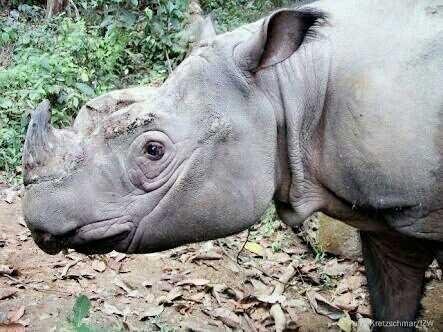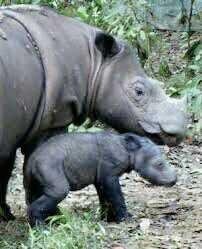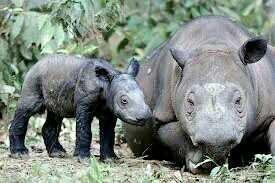Hello friend steemit all wherever you are. Meet me again @joeel. At this encounter @ joeel will discuss about the big body of the Sumatran rhinoceros. As we know its habitat is almost extinct. Therefore, let's save them. But before that it would be good friends all follow my account and upvote. thanks.

Sumatran rhinoceros, also known as rhino-haired rhinoceros or Asian Rhinoceros (Dicerorhinus sumatrensis),are a rare species of the Rhinocerotidae family and belong to one of the five extinct species of rhinoceros. The Sumatran rhino is the only preserved species of the genus Dicerorhinus. This rhinoceros is the smallest rhinoceros, although still belonging to a large mammal. Height 112-145 cm to shoulder, with total body length and head 2.36-3.18 m, and tail length 35-70 cm. The reported weight ranges from 500 to 1,000 kg, with an average of 700-800 kg, although there is a record of a specimen weighing 2,000 kg. As with African rhinoceros species, Sumatran rhino has two horns; the larger is the nasal horn, usually 15-25 cm, while the other horn is usually shaped like a base. Most of the bodies of Sumatran rhinos are covered with reddish brown hair.

Sumatran rhino numbers are difficult to determine because they are widespread scattered animals, but can be estimated if they are less than 100. There are doubts about the survival of the population in Peninsular Malaysia, and one of the populations in Sumatra may be extinct. Their current number may be only 80. In 2015, researchers announced that the east Sumatran rhino in northern Borneo (Sabah, Malaysia) has become extinct.

In most of its lifetime, the Sumatran rhinoceros is an aloof animal, except during the mating period and maintains offspring. They are the most vocal rhinoceros species and also communicate by marking the ground with their feet, twisting a small tree to form a pattern, and leaving behind its droppings. This species is much better to learn than the same closed Javan Rhino, partly because of a program that brings 40 Sumatran rhinos into ex-situ conservation in order to preserve the species. This program is even considered a disaster by its pemrakarsanya; most of the rhino dies and no offspring are produced for nearly 20 years, thus depicting a population decline that is even worse than its habitat in the wild.
By @joeel
Hi! I am a robot. I just upvoted you! I found similar content that readers might be interested in:
https://en.wikipedia.org/wiki/Sumatran_rhinoceros